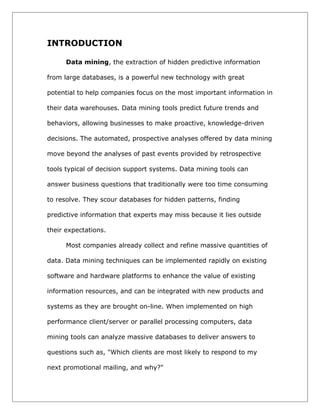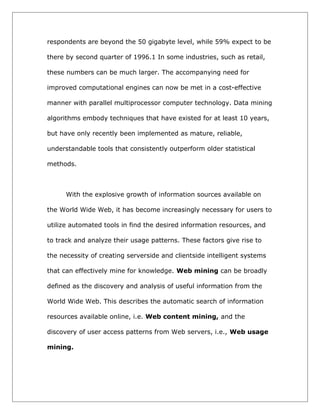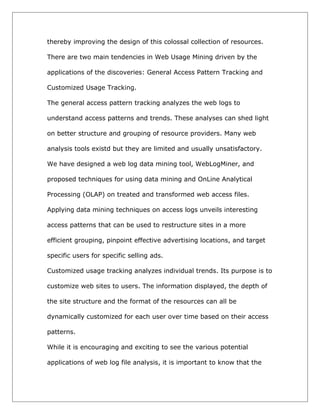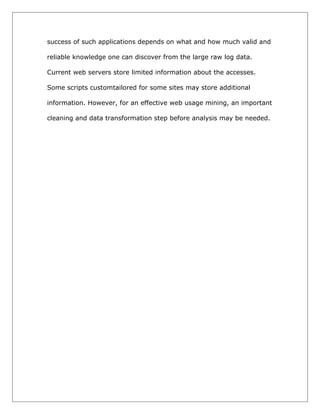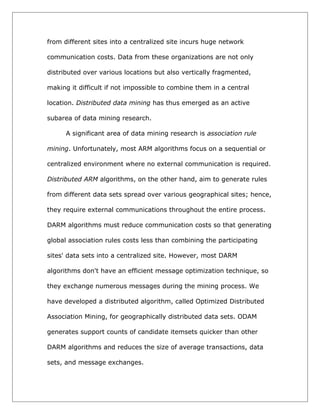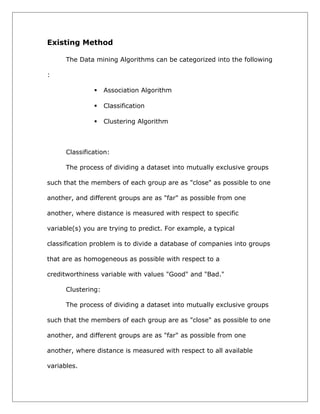Odam an optimized distributed association rule mining algorithm (synopsis)
- 1. ODAM An Optimized Distributed Association Rule Mining Algorithm (Synopsis)
- 2. INTRODUCTION Data mining, the extraction of hidden predictive information from large databases, is a powerful new technology with great potential to help companies focus on the most important information in their data warehouses. Data mining tools predict future trends and behaviors, allowing businesses to make proactive, knowledge-driven decisions. The automated, prospective analyses offered by data mining move beyond the analyses of past events provided by retrospective tools typical of decision support systems. Data mining tools can answer business questions that traditionally were too time consuming to resolve. They scour databases for hidden patterns, finding predictive information that experts may miss because it lies outside their expectations. Most companies already collect and refine massive quantities of data. Data mining techniques can be implemented rapidly on existing software and hardware platforms to enhance the value of existing information resources, and can be integrated with new products and systems as they are brought on-line. When implemented on high performance client/server or parallel processing computers, data mining tools can analyze massive databases to deliver answers to questions such as, "Which clients are most likely to respond to my next promotional mailing, and why?"
- 3. Data mining (DM), also called Knowledge-Discovery in Databases (KDD) or Knowledge-Discovery and Data Mining, is the process of automatically searching large volumes of data for patterns using tools such as classification, association rule mining, clustering, etc.. Data mining is a complex topic and has links with multiple core fields such as computer science and adds value to rich seminal computational techniques from statistics, information retrieval, machine learning and pattern recognition. Data mining techniques are the result of a long process of research and product development. This evolution began when business data was first stored on computers, continued with improvements in data access, and more recently, generated technologies that allow users to navigate through their data in real time. Data mining takes this evolutionary process beyond retrospective data access and navigation to prospective and proactive information delivery. Data mining is ready for application in the business community because it is supported by three technologies that are now sufficiently mature: o Massive data collection o Powerful multiprocessor computers o Data mining algorithms Commercial databases are growing at unprecedented rates. A recent META Group survey of data warehouse projects found that 19% of
- 4. respondents are beyond the 50 gigabyte level, while 59% expect to be there by second quarter of 1996.1 In some industries, such as retail, these numbers can be much larger. The accompanying need for improved computational engines can now be met in a cost-effective manner with parallel multiprocessor computer technology. Data mining algorithms embody techniques that have existed for at least 10 years, but have only recently been implemented as mature, reliable, understandable tools that consistently outperform older statistical methods. With the explosive growth of information sources available on the World Wide Web, it has become increasingly necessary for users to utilize automated tools in find the desired information resources, and to track and analyze their usage patterns. These factors give rise to the necessity of creating serverside and clientside intelligent systems that can effectively mine for knowledge. Web mining can be broadly defined as the discovery and analysis of useful information from the World Wide Web. This describes the automatic search of information resources available online, i.e. Web content mining, and the discovery of user access patterns from Web servers, i.e., Web usage mining.
- 5. Web Mining is the extraction of interesting and potentially useful patterns and implicit information from artifacts or activity related to the WorldWide Web. There are roughly three knowledge discovery domains that pertain to web mining: Web Content Mining, Web Structure Mining, and Web Usage Mining. Web content mining is the process of extracting knowledge from the content of documents or their descriptions. Web document text mining, resource discovery based on concepts indexing or agent based technology may also fall in this category. Web structure mining is the process of inferring knowledge from the World Wide Web organization and links between references and referents in the Web. Finally, web usage mining, also known as Web Log Mining, is the process of extracting interesting patterns in web access logs. Web Content Mining Web content mining is an automatic process that goes beyond keyword extraction. Since the content of a text document presents no machinereadable semantic, some approaches have suggested to restructure the document content in a representation that could be exploited by machines. The usual approach to exploit known structure in documents is to use wrappers to map documents to some data model. Techniques using lexicons for content interpretation are yet to come.
- 6. There are two groups of web content mining strategies: Those that directly mine the content of documents and those that improve on the content search of other tools like search engines. Web Structure Mining WorldWide Web can reveal more information than just the information contained in documents. For example, links pointing to a document indicate the popularity of the document, while links coming out of a document indicate the richness or perhaps the variety of topics covered in the document. This can be compared to bibliographical citations. When a paper is cited often, it ought to be important. The PageRank and CLEVER methods take advantage of this information conveyed by the links to find pertinent web pages. By means of counters, higher levels cumulate the number of artifacts subsumed by the concepts they hold. Counters of hyperlinks, in and out documents, retrace the structure of the web artifacts summarized. Web Usage Mining Web servers record and accumulate data about user interactions whenever requests for resources are received. Analyzing the web access logs of different web sites can help understand the user behaviour and the web structure,
- 7. thereby improving the design of this colossal collection of resources. There are two main tendencies in Web Usage Mining driven by the applications of the discoveries: General Access Pattern Tracking and Customized Usage Tracking. The general access pattern tracking analyzes the web logs to understand access patterns and trends. These analyses can shed light on better structure and grouping of resource providers. Many web analysis tools existd but they are limited and usually unsatisfactory. We have designed a web log data mining tool, WebLogMiner, and proposed techniques for using data mining and OnLine Analytical Processing (OLAP) on treated and transformed web access files. Applying data mining techniques on access logs unveils interesting access patterns that can be used to restructure sites in a more efficient grouping, pinpoint effective advertising locations, and target specific users for specific selling ads. Customized usage tracking analyzes individual trends. Its purpose is to customize web sites to users. The information displayed, the depth of the site structure and the format of the resources can all be dynamically customized for each user over time based on their access patterns. While it is encouraging and exciting to see the various potential applications of web log file analysis, it is important to know that the
- 8. success of such applications depends on what and how much valid and reliable knowledge one can discover from the large raw log data. Current web servers store limited information about the accesses. Some scripts customtailored for some sites may store additional information. However, for an effective web usage mining, an important cleaning and data transformation step before analysis may be needed.
- 9. Abstract With the explosive growth of information sources available on the World Wide Web, it has become increasingly necessary for users to utilize automated tools in find the desired information resources, and to track and analyze their usage patterns. Association rule mining is an active data mining research area. However, most ARM algorithms cater to a centralized environment. In contrast to previous ARM algorithms, ODAM is a distributed algorithm for geographically distributed data sets that reduces communication costs. Recently, as the need to mine patterns across distributed databases has grown, Distributed Association Rule Mining (D-ARM) algorithms have been developed. These algorithms, however, assume that the databases are either horizontally or vertically distributed. In the special case of databases populated from information extracted from textual data, existing D-ARM algorithms cannot discover rules based on higher-order associations between items in distributed textual documents that are neither vertically nor horizontally distributed, but rather a hybrid of the two. Modern organizations are geographically distributed. Typically, each site locally stores its ever increasing amount of day-to-day data. Using centralized data mining to discover useful patterns in such organizations' data isn't always feasible because merging data sets
- 10. from different sites into a centralized site incurs huge network communication costs. Data from these organizations are not only distributed over various locations but also vertically fragmented, making it difficult if not impossible to combine them in a central location. Distributed data mining has thus emerged as an active subarea of data mining research. A significant area of data mining research is association rule mining. Unfortunately, most ARM algorithms focus on a sequential or centralized environment where no external communication is required. Distributed ARM algorithms, on the other hand, aim to generate rules from different data sets spread over various geographical sites; hence, they require external communications throughout the entire process. DARM algorithms must reduce communication costs so that generating global association rules costs less than combining the participating sites' data sets into a centralized site. However, most DARM algorithms don't have an efficient message optimization technique, so they exchange numerous messages during the mining process. We have developed a distributed algorithm, called Optimized Distributed Association Mining, for geographically distributed data sets. ODAM generates support counts of candidate itemsets quicker than other DARM algorithms and reduces the size of average transactions, data sets, and message exchanges.
- 11. Description of Problem After the advent of computer the data are enormously available and by making use of such raw collection data to invent the knowledge is the process of Data Mining. Like wise in Web also plenty of Web Documents resides in online. Web is repository of variety of information like Technology, Science, History, Geography, Sports Politics and others. If any one know about particular topic, then they are using search engine to search for their requirements and it gives full satisfaction for that user by giving entire related information about the topic. We can categorize parallel ARM algorithms as dataparallelism or task-parallelism algorithms. In the former, the algorithms partition the data sets among different nodes; in the latter, each site performs the task independently but must access the entire data set. The Count Distribution (CD) algorithm is a simple dataparallelism algorithm.2 It uses the sequential Apriori algorithm in a parallel environment and assumes data sets are horizontally partitioned among different sites. DARM discovers rules from various geographically distributed data sets. However, the network connection between those data sets isn't as fast as in a parallel environment, so distributed mining usually aims to minimize communication costs.
- 12. Existing Method The Data mining Algorithms can be categorized into the following : Association Algorithm Classification Clustering Algorithm Classification: The process of dividing a dataset into mutually exclusive groups such that the members of each group are as "close" as possible to one another, and different groups are as "far" as possible from one another, where distance is measured with respect to specific variable(s) you are trying to predict. For example, a typical classification problem is to divide a database of companies into groups that are as homogeneous as possible with respect to a creditworthiness variable with values "Good" and "Bad." Clustering: The process of dividing a dataset into mutually exclusive groups such that the members of each group are as "close" as possible to one another, and different groups are as "far" as possible from one another, where distance is measured with respect to all available variables.
- 13. Given databases of sufficient size and quality, data mining technology can generate new business opportunities by providing these capabilities: • Automated prediction of trends and behaviors. Data mining automates the process of finding predictive information in large databases. Questions that traditionally required extensive handson analysis can now be answered directly from the data — quickly. A typical example of a predictive problem is targeted marketing. Data mining uses data on past promotional mailings to identify the targets most likely to maximize return on investment in future mailings. Other predictive problems include forecasting bankruptcy and other forms of default, and identifying segments of a population likely to respond similarly to given events. • Automated discovery of previously unknown patterns. Data mining tools sweep through databases and identify previously hidden patterns in one step. An example of pattern discovery is the analysis of retail sales data to identify seemingly unrelated products that are often purchased together. Other pattern discovery problems include detecting fraudulent credit
- 14. card transactions and identifying anomalous data that could represent data entry keying errors. DARM discovers rules from various geographically distributed data sets. However, the network connection between those data sets isn't as fast as in a parallel environment, so distributed mining usually aims to minimize communication costs. Proposed System Unlike other algorithms, ODAM offers better performance by minimizing candidate itemset generation costs. It achieves this by focusing on two major DARM issues communication and synchronization. Communication is one of the most important DARM objectives. DARM algorithms will perform better if we can reduce communication (for example, message exchange size) costs. Synchronization forces each participating site to wait a certain period until globally frequent itemset generation completes. Each site will wait longer if computing support counts takes more time. Hence, we reduce the computation time of candidate itemsets' support counts. To reduce communication costs, we highlight several message optimization techniques. ARM algorithms and on the message
- 15. exchange method, we can divide the message optimization techniques into two methods direct and indirect support counts exchange. Each method has different aims, expectations, advantages, and disadvantages. For example, the first method exchanges each candidate itemset's support count to generate globally frequent itemsets of that pass (CD and FDM are examples of this approach). All sites share a common globally frequent itemset with identical support counts, so rules that are generated at different participating sites have identical confidence. This approach focuses on a rule's exactness and correctness.
- 16. System Requirement Hardware specifications: Processor RAM : : Intel Processor IV 128 MB Hard disk : 20 GB CD drive : 40 x Samsung Floppy drive : 1.44 MB Monitor : 15’ Samtron color Keyboard Mouse : : 108 mercury keyboard Logitech mouse Software Specification Operating System – Windows XP/2000 Language used – J2sdk1.4.0, JCreator


